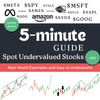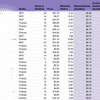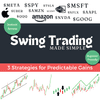📊 Popular Stock Analysis
High ROIC = High Returns? Not Always. Here’s What Most Investors Miss
Fri, May 30, 2025
Table of Contents
Ok picture this
Two kids set up lemonade stands
They each borrow $100 from their parents to buy lemons, sugar, cups, whatever
After a week
Maya ends up with $130
Leo makes $105
They both made money
But Maya’s $100 worked harder
That’s basically the idea behind ROIC
It’s not just about making money
It’s about how well your money actually performed
How Do You Figure Out ROIC
The formula’s simple (and kind of boring tbh):
ROIC = NOPAT ÷ Invested Capital
NOPAT means net operating profit after tax
Invested capital is just the money tied up in stuff the business uses — like equipment, inventory, that kind of thing
So let’s say a business uses $1M and makes $150K in NOPAT
ROIC is 15%
For every dollar they put in, they got 15 cents back
Decent
Now if another company makes that same $150K but had $3M invested
ROIC drops to 5%
Money’s working slower there
If you’re into analyzing this stuff on your own, using something like TradingView can help pull up the data without scrolling through 10-Ks
Why Should You Care About ROIC as an Investor
A company might show strong profits
But how much did it need to spend to get there?
That’s where ROIC becomes useful
It shows how efficient a business is at using its capital
You want the ones that get more out of less
High ROIC usually means the company has something going for it — maybe smart management, maybe a business model that doesn’t need a ton of cash to scale
Those are the ones that tend to do better over time
If you’re just starting out and want to track your investments in one place, Personal Capital gives you a pretty clear overview of how your portfolio’s actually working
Examples of Companies with High and Low ROIC
Take Apple ($AAPL)
Their ROIC often stays up in the 25%–40% range
They don’t need to throw tons of money at problems
They build smart and get solid returns
Ford ($F), on the other hand, operates in a very capital-heavy space
Factories, supply chains, huge inventories
Their ROIC often sits around 4%–9%
Not necessarily bad — just a different kind of business
Alphabet ($GOOG) shows strong ROIC too
But now that it’s so big, it doesn’t always have obvious places to reinvest at the same return
You see them hold more cash or buy back shares instead
For those curious to test ROIC filters across industries, the TradingView Screener has some handy presets you can play around with
Is High ROIC Always a Good Thing?
It usually is, yeah
But there’s a catch
A company might have amazing ROIC but no way to reinvest that capital
So it earns well but doesn’t grow fast
You’ll often see that with mature tech companies
Also, some businesses just aren’t built to have high ROIC
Utilities, airlines, auto companies — they need a lot of infrastructure
Low ROIC comes with the territory
So context matters
What Do People Get Wrong About ROIC
Some folks just look at the number and stop there
But you gotta ask where it’s coming from
Was it a fluke year? Did they sell something big?
One good year doesn’t mean it’s a great business
Also — don’t compare ROIC across totally different industries
Software vs airlines? Not even close in structure
Better to compare inside the same space
One more thing — watch for tricky accounting
Some companies make invested capital look smaller
Which makes ROIC look higher than it really is
Always worth checking how they calculate it
How Do You Actually Use ROIC in Your Research
Start simple
Check a company’s ROIC over the last 5–10 years
Is it steady? Going up? Weirdly volatile?
Then ask
Are they reinvesting those returns into the business?
Or just sitting on cash? Or buying stuff that doesn’t earn much?
If you’re feeling extra nerdy
Compare ROIC to something called WACC (weighted average cost of capital)
As long as ROIC is above WACC, the company’s creating value
Below it? Kinda just burning money
Apps like Robinhood or Webull can make this easier if you’re into checking earnings and key stats on your phone without opening 12 tabs
So What’s the Takeaway Here
ROIC isn’t loud
It won’t show up in headlines
But it tells you a lot about how wisely a company uses its money
If you care about owning businesses that don’t waste capital
ROIC is worth paying attention to
It won’t tell you everything
But it quietly filters out the noise
Not financial advice, just sharing my thoughts!
Related Posts
Free Cash Flow Margin (FCF Margin) - Revenue Lies. Profit Misleads. This Tells the Truth.
Tue, Jun 10, 2025
Learn how free cash flow margin reveals a company’s real cash health beyond profit and why it matters for smarter investing decisions.
Free Cash Flow - This One Number Reveals What a Company Really Makes
Fri, Jun 6, 2025
Learn what free cash flow really means, how to calculate it, and why it matters more than revenue in stock analysis.
Return on Equity (ROE) Explained: How Smart Investors Use This Metric to Pick Winning Stocks
Sun, Apr 20, 2025
Learn how Return on Equity (ROE) helps investors spot profitable stocks, avoid value traps, and make smarter investment decisions with real-world examples.





